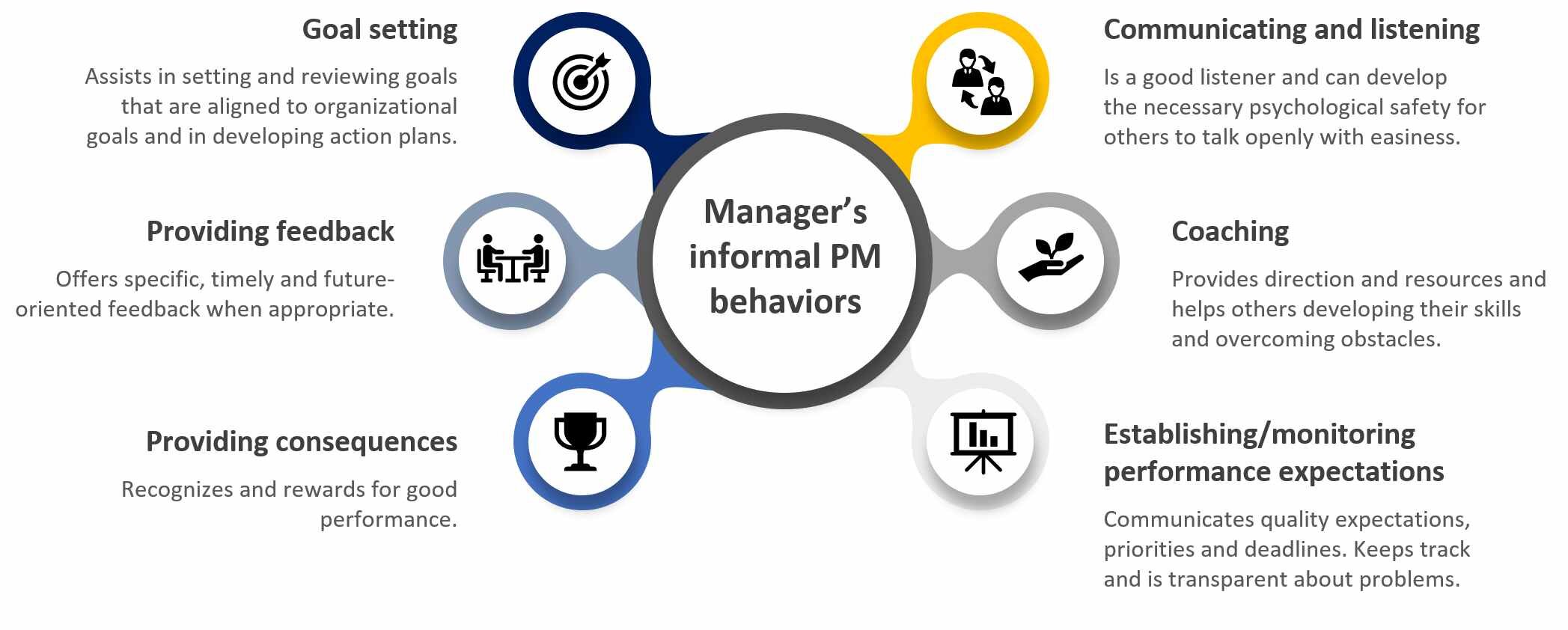Digest 11. Six effective managerial behaviors for informal performance management and how to assess them
As performance management shifts its focus from the traditional once-a-year appraisal towards a more informal system centered on the continuous development of employees, managers’ behaviors and skills become increasingly relevant. Indeed, despite the well-known challenges in implementation, the traditional process is easier to impose and control for managers than the recently proposed informal systems, which requires on-going performance feedback and communication with employees. In fact, such informal exchanges highly depend on managers’ willingness and proactivity. Hence, organizations are responsible to ensure that managers are adequately trained on effective performance management behaviors, and also to track and reward the intended behaviors.
Realizing the lack of a reliable and valid tool for this purpose, a group of researchers from the US developed a 27-item questionnaire of performance management behaviors (PMBQ). Their study used evaluations of 1,323 focal managers expressed by 2,717 direct reports, 2,181 peers and 348 direct supervisors from companies operating in diverse industries, plus 676 undergraduate students. The psychometric properties of PMBQ were strongly supported. In other words, the questionnaire is valid, reliable, and effectively assesses managerial behaviors that are relevant for informal performance management. Let’s see more in detail the questionnaire.
The Performance Management Behaviors Questionnaire (PMBQ)
The scientific literature offers a handful of performance management models which differ in complexity, detail, number of phases, and degree of engagement required to managers and employees. Nevertheless, these models share similarities in terms of the behaviors necessary to execute effective performance management. These are spread between the phases of “Define Performance”, “Evaluate Performance”, “Review Performance” and “Provide Performance Consequences”. By integrating these existing models, Kinicki, Jacobson, Peterson and Prussia (2013) developed their PMBQ by identifying 6 dimensions of managers’ behaviors. The PMBQ asks team members to rate the frequency with which their managers display the behaviors subsumed by the 6 following dimensions:
Goal setting: managers should be able to assist and involve their employees in the process of setting performance objectives, development goals and action plans. Leaders are responsible to ensure alignment between their team’s goals and the organization’s vision and strategy. It is important to get the participation of individuals in this process as they increasingly expect more empowerment and, therefore, measure managers’ efforts in involving their employees in the goal setting process;
Communicating and listening: contrarily to the intuitive idea that good communicators are the ones able to express their views and opinions clearly, this dimension focuses on rating managers’ listening skills (to know how to foster good listening abilities check our digest 10). Additionally, managers should have the capacity to create a psychologically safe environment so that employees find easy to approach them and talk openly;
Providing feedback: offering timely, specific and constructive feedback is an ever more important skill for managers to possess. To learn what is proper constructive feedback and why immediacy and frequency are important, read our digest 3.
Coaching: managers’ coaching behaviors positively impact employee’s performance (for empirical evidence on this read our digest 6). More than being an “appraiser” in the performance management process, supervisors must be able to develop their employees, helping them identify solutions for their challenges and ensuring their learning and engagement.
Providing consequences: knowing when and how to offer recognition and praise is another skill which should be measured. Managers that are competent in reinforcing behaviors never dismiss the importance of rewarding good performance;
Establishing/monitoring performance expectations: being clear on performance standards decreases the sense of uncertainty about how to act in order to reach goals, consequently having an impact on employees’ well-being. Moreover, employees need to know if they are on track on a continuous basis, so managers should be able to check the quality of their work and communicate when changes or problems occur.
Organizational implications
We recommend that the PMBQ (or its dimensions) is integrated in the HR practice architecture of any organization with the goal to produce a high-performance culture. This questionnaire can be a useful tool for selecting, promoting and developing managers.
Organizations may ensure better recruitment and selection of managers by building behavioral-based interviews or scenarios to evaluate the degree to which candidates have used these behaviors in their previous work experiences or would use them in the situations prospected;
Evaluating the performance of managers by using these criteria and associating it to promotions and compensation would be an effective strategy to communicate and reinforce the importance of these behaviors and their alignment with an organizational culture rooted in development and continuous learning;
Performance management behaviors can also be integrated into learning and development processes. For example, the results of a 360º PMBQ assessment could help managers setting their developmental goals. Moreover, organizations can have an overview of the training needs and invest in the development of specific performance management skills for leaders.
——
Reference: Kinicki, A. J., Jacobson, K. J. L., Peterson, S. J., & Prussia, G. E. (2013). Development and Validation of the Performance Management Behavior Questionnaire. Personnel Psychology, 66(1), 1–45. https://doi.org/10.1111/peps.12013

